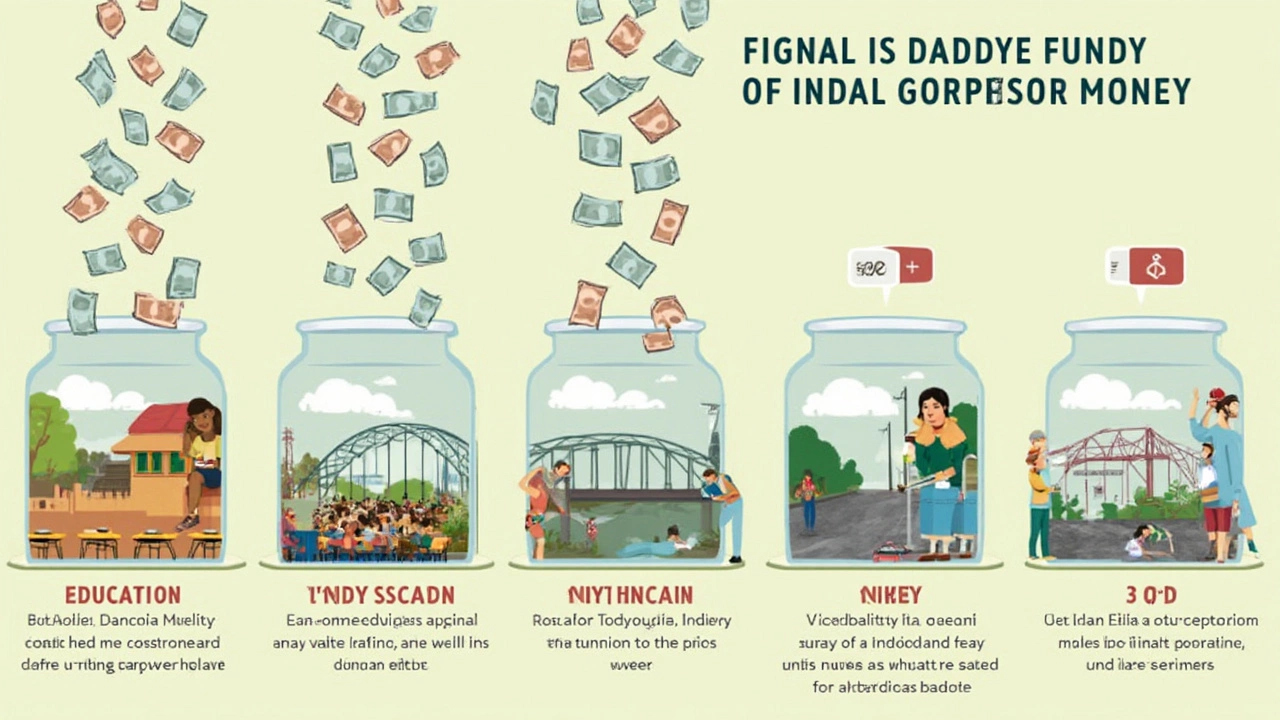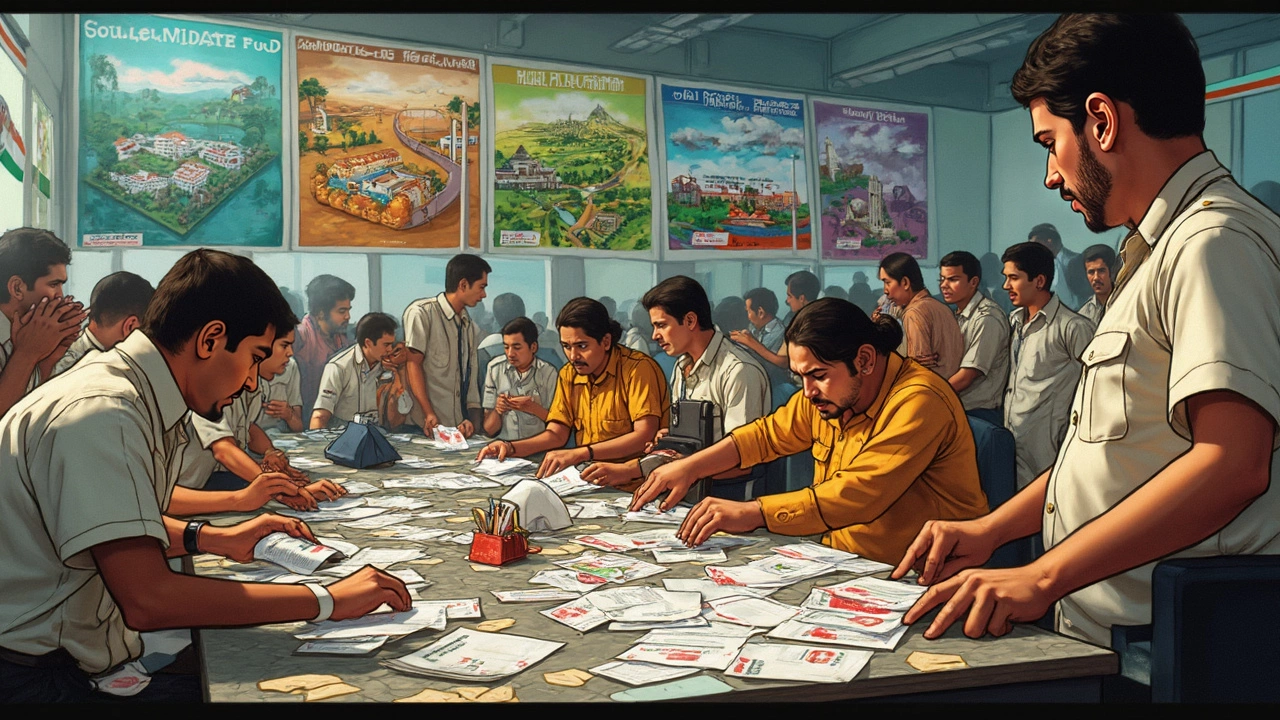You pay taxes, but ever wonder where it all goes? Government funds run the whole show in India—from pensions to highways to free school lunches. Figuring out the types can clear up why certain schemes launch, why some payments are delayed, and honestly, which politician is boasting nonsense.
Most folks have heard of the budget, but that’s just a summary of money moving in and out. The nuts and bolts are these funds: each one stacks cash for a particular reason. Some are always busy, like the Consolidated Fund, while others sit quietly until disaster strikes—think the Contingency Fund. Knowing what each fund does can help you follow the news, check official spending, even spot if your favorite scheme is likely to get more resources next year.
- What Exactly Are Government Funds?
- The Big Three: Consolidated, Contingency, and Public Account
- Dedicated Central Funds: Focus on Welfare
- State Government Funds: How States Manage Money
- Special Purpose Funds You’ll Want to Know
- How to Track and Understand Fund Usage
What Exactly Are Government Funds?
Government funds are like big buckets where the Indian government pools money—mostly collected from taxes, fines, or borrowings—to pay for everything it does. These aren’t random cash piles. Each fund has a clear purpose, legal backing, and strict rules on how and where money can be spent. If you hear terms like government funds India or types of funds in the news, they’re talking about these specific money pools.
The system keeps things organized. Imagine if every rupee went into one messy wallet—tracking who paid what and where the money goes would be a nightmare. Instead, India splits its finances into separate funds. This setup also lets Parliament and state assemblies keep an eye on spending, so it’s not just a free-for-all.
Three main types of government funds form the backbone:
- The Consolidated Fund, which handles almost all revenue and spending by both the central and state governments.
- The Contingency Fund, kept aside for emergencies like floods or sudden crises.
- The Public Account, where the government just acts as a banker, holding money that technically belongs to others—the pension funds or provident funds are classic examples.
Here’s how the main ones stack up in terms of value, just to give you a real sense of size:
| Type of Fund | 2023-24 Estimated Value (₹ crore) |
|---|---|
| Consolidated Fund (Central) | 48,00,000+ |
| Contingency Fund (Central) | 30,000 |
| Public Account (Central) | ~2,00,000 |
Every scheme, from major highways to local health clinics, taps into one of these. By understanding these buckets, it’s way easier to grasp why something gets funded—or doesn’t—each year. So next time you see budget arguments on TV, you’ll know which "bucket" they’re really fighting over.
The Big Three: Consolidated, Contingency, and Public Account
If you want to really understand government funds India, you’ve got to start with the big three: the Consolidated Fund, the Contingency Fund, and the Public Account. These are the main buckets the government uses to collect, spend, and store money.
1. Consolidated Fund of India
This is the government’s main bank account. All income—from taxes, loans, and most receipts—goes here. Every government payment, like salaries, welfare, or defence spending, is paid from this fund. It’s so important that nothing leaves this account without Parliament’s approval. You’ll hear this often during the Union Budget debates.
Here’s a good tip: if you see a new scheme being talked about, check if money for it is coming from the Consolidated Fund. That means Parliament had to discuss and green-light those expenses, so it’s a big deal.
2. Contingency Fund of India
Think of the Contingency Fund like an emergency wallet. If there’s a sudden disaster—like a flood, earthquake, or some urgent unexpected cost—money can be taken from here instantly, without waiting for Parliament to meet. Of course, they have to report it afterward. Right now, this fund is capped at Rs. 500 crore. That’s not huge compared to the total budget, but it can move super-fast when the government’s got no time to waste.
3. Public Account of India
The Public Account is a bit different. The government is just minding someone else’s money in this fund. This includes things like PF (Provident Fund) deposits from government employees, postal savings, and small savings collections. The government can’t spend this money whenever it wants—it has to return it to whoever put it in, eventually.
Here’s a quick breakdown for clarity:
| Fund Name | Main Use | Who Approves Spending? |
|---|---|---|
| Consolidated Fund | All routine receipts and expenses | Parliament |
| Contingency Fund | Emergency or urgent expenses | Government (with later reporting) |
| Public Account | Money held in trust (savings, deposits, etc.) | Government (acts as a banker, not owner) |
Understanding these three funds helps you see why sometimes a scheme is delayed (Parliament was still discussing it), or why the government can act quickly during disasters (that’s the Contingency Fund in action). Next time you hear news about "releasing funds" or "Parliament sanctioning expenditure," you’ll know exactly which fund they’re talking about.
Dedicated Central Funds: Focus on Welfare
Here’s where things get interesting. The central government isn’t just running the country; it’s also stacking money in separate pots for everything from rural jobs to health insurance. These government funds India are built to tackle specific, big problems and usually have their own rules about what the money can be used for.
One of the most talked-about is the National Social Assistance Fund. Set up to support old age pensions, widows, and disabled citizens, this fund keeps schemes like the Indira Gandhi National Old Age Pension Scheme up and running. Monthly pension slips? The money comes from here.
Another heavy-hitter is the National Disaster Response Fund (NDRF). When floods, cyclones, or earthquakes hit, this is the fund that moves quickly. States tap into it for relief work, and the rules are super strict—no government can dip into this cash unless there’s a real emergency.
Let’s not forget the Prime Minister’s National Relief Fund (PMNRF). You’ll see this name pop up after any big disaster, and even common folks can contribute to it. It helps families hit by emergencies, funds some medical treatments, and has been around since 1948.
- Central Road Fund: Fuels road and bridge projects. If you’re annoyed with bumpy national highways, this is the fund to watch.
- National Clean Energy Fund: Financed by a coal cess, goes into renewable energy projects. Basically, it’s the bank for India’s green energy dreams.
- Compensatory Afforestation Fund: Used for replanting trees when forests are cut down for development. Lots of money sits unused in this one, making it a hot topic every budget season.
If you want to see how much money is sitting in these types of funds, the government actually publishes stats every year. Here’s a quick look at some major fund balances, last updated in the Union Budget 2024–25:
| Fund Name | Estimated Balance (₹ Crore) |
|---|---|
| NDRF | 14,500 |
| Compensatory Afforestation Fund | 53,000 |
| National Social Assistance Fund | 9,350 |
The takeaway? If you care about government schemes or want to track how public money is used, these welfare-focused government funds India are the place to start. Keep tabs on them, and you’ll always know how the central government is planning and spending on the big issues that affect regular people.

State Government Funds: How States Manage Money
Ever notice how schools, roads, and hospitals work (or sometimes don’t) in your state? That’s down to how state governments shuffle and spend their money. Just like the centre, every state in India has its own main three government funds: the Consolidated Fund, the Contingency Fund, and the Public Account—each doing a unique job.
The State Consolidated Fund is the biggie—it’s where all state tax collections, big loans, and grants from the centre end up first. From here, salaries for teachers, funds for pothole repairs, scholarships, and everything in between get paid out. Not a single rupee leaves this fund without the okay from the state legislature. It’s basically the financial nerve center.
When floods or a health emergency hits, the State Contingency Fund comes to the rescue. This one’s never huge (Karnataka’s, for example, has been around ₹80 crore) but lets states react fast. The Chief Minister can dip into it without waiting for the assembly’s approval. Of course, the spend has to be reported soon after, but it buys time in a crisis.
The State Public Account is more of a parking lot for money. Here, stuff like employee provident funds, small savings schemes, and deposits from courts are kept. It’s not spending cash—the government just holds it safely till the right person comes to claim it (or investments mature).
| Fund Name | Main Purpose | Requires State Assembly Approval? |
|---|---|---|
| Consolidated Fund | All income and expenses | Yes |
| Contingency Fund | Emergency spending | No (immediate), Yes (later) |
| Public Account | Deposits held in trust | No |
States also run separate funds for things like rural roads (PMGSY), midday meals, and health insurance, but these mostly just move cash between the big three or get topped up by the Centre.
Here’s a handy tip: You can actually peek at how your state’s spending stacks up—just search for the annual state budget online. Want extra detail? Look for the "Finance Accounts" or "Appropriation Accounts" for your state, published every year.
Special Purpose Funds You’ll Want to Know
Let’s get real—government funds in India aren’t just about bills and highways. A lot of money is set aside for specific problems or big plans. These special purpose funds are laser-focused. If there’s a crisis or a long-term mission, you’ll usually find a fund backing it up.
Probably the most popular one lately? The PM CARES Fund. Created after COVID-19 hit, this fund supports emergency health and disaster relief. It’s fueled by donations too, not just government cash. Crores of rupees went through it during the pandemic for things like ventilators and migrant worker help. That’s how flexible a fund can be—set up fast and used where it hurts most.
Another big one is the National Clean Energy Fund (NCEF). The government started taxing coal back in 2010 and pumped that tax into clean energy projects. Solar parks, wind power plants, you name it. If green tech is your thing, this is where you want the action to be.
Then you have the National Disaster Response Fund (NDRF). Heard about flood or cyclone relief funds on the news? Most of that money flows from NDRF. States can request help, and once the government checks out the situation, funds get released to cover shelters, food, and clean-up.
- PM CARES Fund: Emergency response, health, disaster aid.
- National Clean Energy Fund: Supports renewable energy, carbon-reduction projects.
- National Disaster Response Fund (NDRF): Quick support for states facing natural disasters.
- Member of Parliament Local Area Development Scheme (MPLADS): Gives MPs money each year to spend on local needs like schools or water, so citizens see real changes near their homes.
- Backward Regions Grant Fund (BRGF): Targets districts that lag in growth with extra cash for roads, education, and health.
Want a quick peek at where money lands? This table shows recent allocations for some popular special funds:
| Fund Name | 2023-24 Allocation (₹ Crore) |
|---|---|
| PM CARES Fund | 11,500 |
| NDRF | 12,180 |
| NCEF | 9,560 |
| MPLADS | 3,950 |
Each of these types of funds works differently, so if you ever spot a headline about new relief schemes or fancy renewable energy projects, now you know exactly what bucket the cash is coming from. It’s smart to keep an eye on who manages these funds and how they get audited. A few minutes following these details can show if public money’s really helping where it should—or getting lost in paperwork.
How to Track and Understand Fund Usage
If you want to see exactly how government funds in India are spent, you don’t have to be a finance expert. There are actual tools and official sites made for people who care about where the money goes—no fancy jargon, just real numbers and updates.
The Ministry of Finance puts out detailed reports every year. Check the Union Budget (budget.gov.in) for a breakdown of all major types of funds, what came in, and what’s been spent. If you prefer state-level info, each government’s finance department posts their own separate budget and fund usage reports, usually right on their websites (for example, Maharashtra's finance site: mahafinance.gov.in).
Tracking smaller government schemes and dedicated government funds India is actually pretty simple if you know where to look:
- Public Financial Management System (PFMS): This site (pfms.nic.in) lets you trace government payments to specific schemes, districts, and even beneficiaries. Pretty handy if you want to check if a welfare payment reached your area.
- Comptroller and Auditor General (CAG) Reports: These are audits of public finance and fund usage by central and state governments. CAG reports can reveal if money is spent properly or if there’s shady business.
- For major ongoing schemes like the MGNREGA or PM-Kisan, both have their own portals displaying real-time spending, payments disbursed, and pending bills. No more guessing if a promised fund is still stuck somewhere.
If you want to see the overall flow, here’s a quick sample from the FY 2023-24 Union Budget:
| Fund Name | Budgeted Amount (₹ Crore) | Spent till Dec 31 |
|---|---|---|
| Consolidated Fund | 44,06,002 | 28,65,000 |
| Contingency Fund | 500 | 80 |
| Public Account | 13,12,000 | Varies (mainly deposits/withdrawals) |
Here’s a pro tip: If a politician claims a big project is "fully funded," use these sources to check if the money actually moved. Same for any news of unspent funds or delays—CAG reports often give specifics, even naming departments dragging their feet.
Don’t want to dig into PDFs? News sites like The Hindu and LiveMint summarize budget data and government spending in plain English right after each major update. Use that as your quick scan, then look up the official numbers if something catches your eye.


